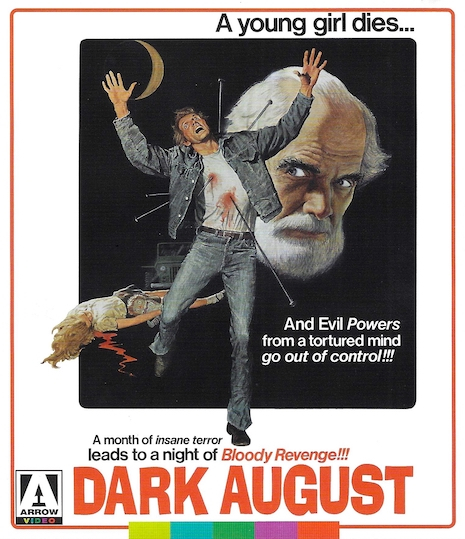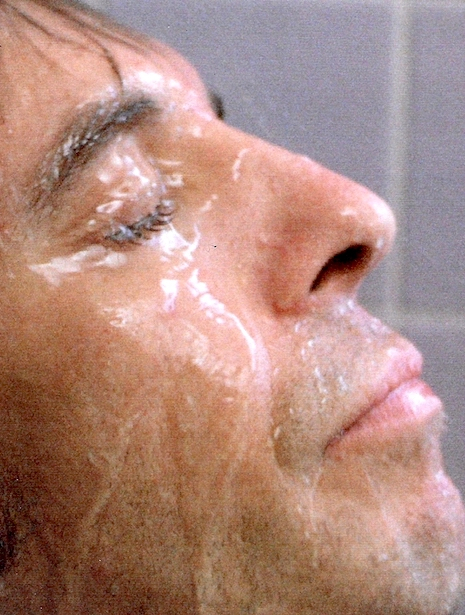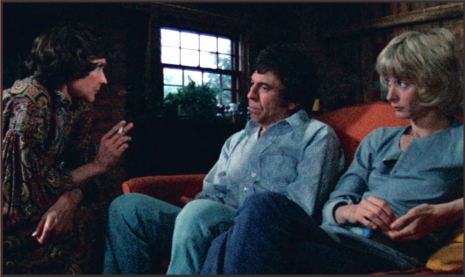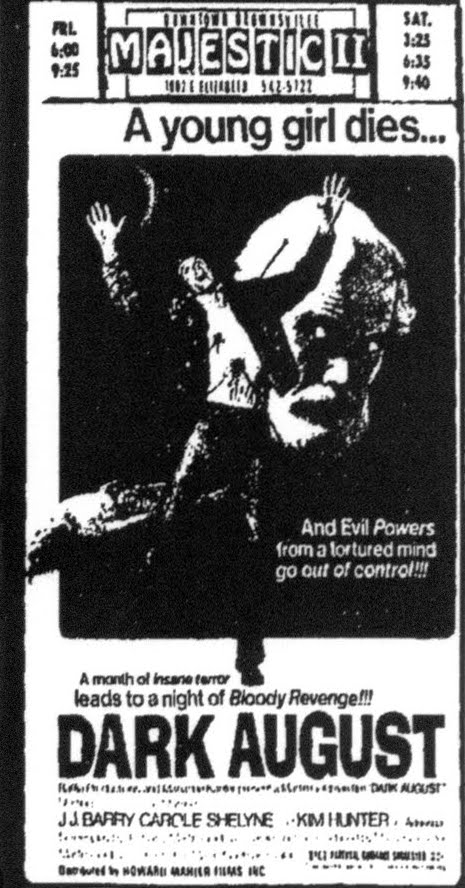
The movies that make up Arrow Video’s American Horror Project series were made with modest budgets, but the makers of these ‘70s motion pictures were striving for something more than simply churning out another scary flick for the grindhouse and drive-in circuits. The films are all highly imaginative and unique works. The first volume of AHP, which came out in 2016, is outstanding, and volume two is about to be released. Like the first set, the second box contains three movies, and this post highlights our favorite film in the collection.
Dark August (1976) was directed by Martin Goldman, and filmed on location in Stowe, Vermont during the summer of 1975. The film concerns Sal, a middle-aged artist who has left the city behind for country life. One day, he accidentally runs over a young girl with his jeep. Not only is Sal understandably haunted by the incident, he’s also the recipient of a curse, put on him by the bereaved grandfather of the dead girl. Academy Award winner, Kim Hunter, plays Adrianna, a “good witch” who is recruited to try to help Sal.
In addition to the occult horror theme, the film makes good use of its rural setting, incorporating elements of the “city vs. country” subgenre, popularized by the recent box office success of movies like Deliverance (1972) and The Texas Chain Saw Massacre (1974). At its core, Dark August is a psychological film with supernatural elements. It has an appealing visual style, with camera framing and movement a priority. There’s also a focus on pacing and mood, with on-screen bloodletting kept to a minimum. For an exploitation horror film, Dark August is remarkably restrained.

American Horror Project: Volume Two is co-curated by musician and author Stephen Thrower. Since the 1980s, he’s written extensively about unconventional horror films and filmmakers. The books he’s penned include Nightmare USA: The Untold Story of the Exploitation Independents.
Dangerous Minds recently interviewed Stephen Thrower about Dark August and the American Horror Project series.
When did you first see Dark August? What were your initial impressions?
Stephen Thrower: I saw it for the first time in the early 2000s, when I was working on my book Nightmare USA. I liked it for its atmosphere, its unclichéd presentation of the occult, and its subtle buildup of unease, and also for its grasp of the power of environment: the setting of Dark August is palpably real, somewhere lived in and authentic.
What do you think director Martin Goldman was trying to achieve, artistically, with the film?
Stephen Thrower: I think the compositional and textural qualities of the image are quite ‘novelistic,’ the equivalent of creating detailed settings in literary fiction. It seems to me that Goldman was aiming for a character drama with elements of supernatural fiction, almost in a literary sense, like Henry James’ Turn of the Screw or M.R. James’ Casting the Runes. He’s aiming for a very subtle sort of horror film that creeps up on the viewer without undermining the reality of the performances or compromising their naturalism. It’s a study of the corrosive nature of guilt, and at the same time about the equally corrosive nature of revenge.

How did the casting of Kim Hunter come about?
Stephen Thrower: She was sympathetic to the nature of the film, and took an interest in ESP and the paranormal, which helped to attract her to the project. It was shot in 1974, just a year after The Exorcist gave Ellen Burstyn’s career a huge lift, so perhaps she saw the supernatural and the uncanny as a good career move at that point too.

I couldn’t find any reviews from the ‘70s, but the general consensus of the film these days is negative. Why do you think that is?
Stephen Thrower: Well, it’s not widely seen; for instance, I think there are currently only four or five comments on IMDb for it. The bad reviews seem to me to be castigating the film for not being as ‘intense’ or ‘horrific’ as the reviewers were looking for. As a consumer, sometimes you want something in particular and feel disappointed when you don’t get it. But it’s the job of a reviewer to rise above that fairly mundane response and ask, what is the film trying to do, and how well does it achieve that aim? Dark August isn’t a balls-to-the-wall shocker, it’s not a film where you get your friends over and pop a few beers, it’s something that works best when you’re home alone, on a quiet rainy evening, and you want to watch a film that evokes that quiet sense of unease that you get from a literary ghost story; something oblique and moody like Robert Aickman, not a shocker in the Richard Laymon mold!
What sort of distribution did the film have?
Stephen Thrower: For some reason there was not a lot of fuel in the engine when it came to getting this film distributed. Howard Mahler Films picked it up, and they mainly handled action and kung fu pictures, although they did dabble in horror occasionally: they had Dario Argento’s Deep Red (aka The Hatchet Murders) in circulation at the same time as Dark August. Mahler also seems to have had an eye for the unusual: around the same time as Dark August he distributed a very odd film called The Transformation: A Sandwich of Nightmares (1974) by the future director of Christmas Evil, Lewis Jackson, and he put out Jess Franco’s Le journal intime d’une nymphomane (1972) as Diary of a Nympho. For some strange reason, though, he only played Dark August in the south: Texas, Mississippi, Alabama, Louisiana, Florida, Oklahoma. It stayed around for a few years down there. I think the last time it was screened, as far as I can tell, was in Mississippi in September 1980, on a double bill with, of all things, Mad Magazine’s Up the Academy, a comedy so bad that Mad Magazine disowned it in their own pages! I really don’t understand why Dark August only played in the south, it seems to me it could have just as easily made money in northern cities like Chicago and Detroit. As far as I can tell it didn’t even get a local theatrical release in Vermont, although it’s possible that the available archives are incomplete.

Texas theater ad.
What’s your current view of Dark August?
Stephen Thrower: I think it will benefit hugely from high definition Blu-ray. A lot of effort went into the photography and the old VHS editions didn’t do it justice at all. The cinematography is gorgeous, the location filming is atmospheric and evocative, and the rural setting, Vermont, is rarely seen in the movies. The only other horror films shot in Vermont, that I’m aware of, are Terror Train, Ghost Story, Something Wicked This Way Comes, and Return to Salem’s Lot, all of which were made in the 1980s, and these were not local productions, they were studio pictures shooting on location.

In your view, what makes the films included in the American Horror Project series appealing?
Stephen Thrower: I’ve always thought that one of the key ingredients of a good horror film is surprise. It doesn’t have to be a shock-surprise, like the hand at the end of Carrie, it can be a surprising or startling aesthetic choice, or a peculiar narrative twist, or an eccentric performance. Anything that steps out of the ordinary. The great thing about these low budget independent films of the 1970s and 1980s is that the people who made them were not media-savvy industry insiders with a massive amount of experience, they were out there on their own, often miles away from the commercial hubs of the industry, coming up with their own bespoke solutions to the problems and challenges of filmmaking. They have a strange sort of charm, and an unpredictability that I find very pleasing. In the 1970s there was, of course, no internet where people could pool ideas, and therefore no immediately accessible consensus to homogenise their approaches. The films were weird and diverse and idiosyncratic, and there was often genuine artistry to them. Nowadays there’s a huge swathe of work in the genre that’s done by people who have all been to the same film schools, or they’ve read the same ‘How-To’ books, and the post-production studios use the same software packages: you can give your colour grading the same gloomy desaturated ‘horror’ look as everything else in the Netflix horror section. I think people are so fascinated with 1970s horror films because they were the last great blooming of ‘outlaw’ filmmaking, away from the influence of the major studios and unrestricted by mainstream expectations.
Are there going to be more volumes of American Horror Project?
Stephen Thrower: I’m happy to say that we have another one already lined up and as long as the buying public like what we’re doing we’ll keep on doing it.
The opening of Dark August is really something. As Dangerous Minds is premiering the sequence in its restored form, it’d be great to have your thoughts on it.
Stephen Thrower: This gorgeous opening scene depicts an old man placing a curse on the lead protagonist in the movie. It puts us right at the pivotal moment of the plot, which is the curse, even before we’ve met the characters. It’s very bold in execution, beautifully photographed, and features some extraordinary musical elements. The photography is worthy of someone like Vilmos Zsigmond, who shot McCabe and Mrs. Miller (1971) and Images (1972) for Robert Altman, and many other great films such as Deliverance (1972) and Blow Out (1981). It’s very stylish and elegant in composition and pacing, and it’s not afraid to disorientate the viewer. A more cautious director would have put this sequence ten minutes into the film, and used the credit sequence for ‘scene-setting’, establishing normality before disrupting it. By doing things this way, Goldman ensures that even the early scenes have a sense of something malign and disturbing hovering over them. The music is amazing too, in fact it’s pretty strange throughout the film. This sequence is a good indication of the audio-pallette: eerie sound-collage mixed with elements of progressive rock. It’s actually quite similar to some of the stuff coming out of Italy in the 1970s.
*****
Here’s the web premiere of the stunning opening of Dark August in all its restored glory:
American Horror Project: Volume Two will be released on June 25th as a limited edition Blu-ray set. Along with Dark August, AHP 2 includes the correspondingly obscure oddities, Dream No Evil (1970) and The Child (1977). The films are presented in new 2K restorations, and there’s loads of bonus content. Pre-order the three-disc box via MVD or Amazon.

Previously on Dangerous Minds:
The surreal nightmare that is ‘70s cult film oddity ‘Malatesta’s Carnival of Blood’
Fiona Apple’s dad plays a crazed, killer Santa Claus in a John Waters favorite, ‘Christmas Evil’
The creeptastic ‘mad puppet’ in Dario Argento’s shocker ‘Deep Red’ will haunt your dreams